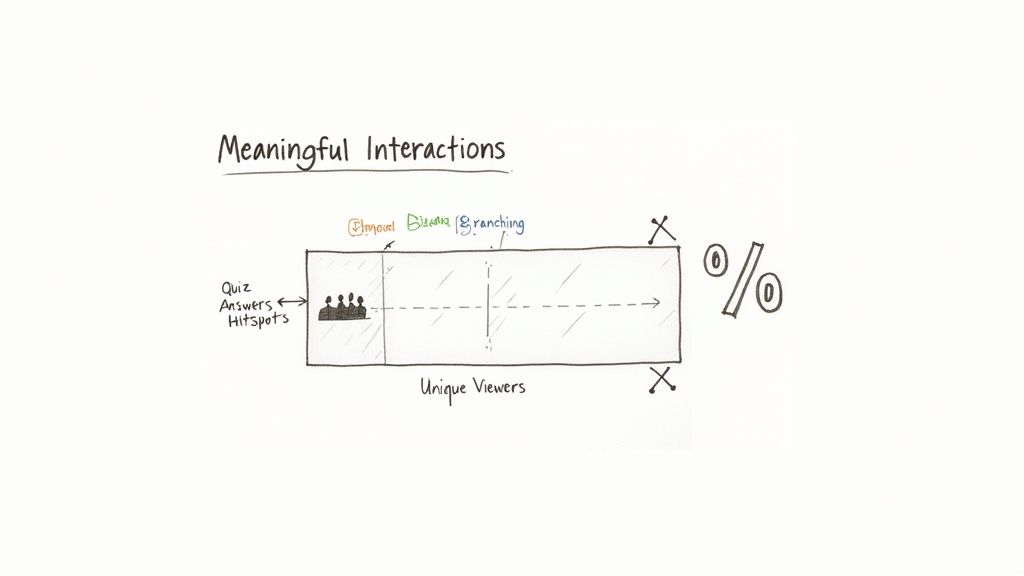
what is engagement rate: Measure and boost training videos
When it comes to corporate training, engagement rate is the single most important metric for understanding active learning. It cuts through the noise to show you how much your employees are actually interacting with the training content, not just how many people hit the ‘play’ button.
A high engagement rate is your best indicator that learners are leaning in and getting involved, which almost always leads to better knowledge retention and real-world skill application.
Unpacking Engagement in Corporate Training

Let’s be clear: this isn’t about social media metrics. For Learning and Development (L&D) pros, engagement rate is all about tracking meaningful actions inside your training materials. A standard, linear training video is like a one-way lecture—information is broadcast, and your team is expected to absorb it passively.
An interactive video, on the other hand, turns that lecture into a hands-on workshop. In this setup, a high engagement rate means your employees are essentially "raising their hands." They’re actively participating in their own learning journey, not just sitting in the back of the room.
In corporate training, engagement isn't about likes or shares; it's about clicks, responses, and choices that demonstrate comprehension and active participation. This data provides a far richer story about training effectiveness than merely knowing who pressed play.
Instead of chasing vanity metrics, you get to focus on actions that have a direct line to learning outcomes. These interactions are the bedrock of an effective training program and give you a crystal-clear picture of how well your content is landing with your team.
What Does Active Participation Look Like?
When we talk about engagement in a training video, we're really talking about any interaction that forces a learner to stop, think, and respond. It's the difference between listening and doing.
To give you a better idea, here's a look at the kinds of interactions that truly signal someone is engaged with a training video.
Key Interactions That Define Training Video Engagement
Each of these actions is a valuable data point. It tells you not only that someone is paying attention, but also what they're paying attention to, giving you incredible insight into what's working and what isn't.
Why Engagement Is Your Most Important Training Metric

For years, Learning and Development (L&D) teams have leaned on a single metric to measure success: completion rates. But let’s be honest, that number only tells you if an employee made it to the end of a video—not if they actually learned anything along the way.
That’s where engagement rate comes in. It paints a much clearer, more honest picture of your training's real return on investment (ROI). It’s the difference between someone passively watching and someone actively participating. And that difference is everything.
High engagement isn't just a vanity metric; it's directly tied to better knowledge retention. When learners are clicking, answering, and interacting, they're not just consuming information—they're processing it. That's where real learning happens.
Imagine two employees "complete" the same mandatory safety video. One has it playing in the background while they check emails. The other correctly answers every interactive question embedded in the video. Completion data says they're the same. Engagement data tells you who is actually ready to do their job safely.
From Passive Viewing to Active Learning
When you start measuring engagement, you naturally shift your focus from simply delivering content to driving real learning outcomes. It stops being about checking a box and starts being about making sure your team truly understands and can apply what they’ve seen.
Thinking about the principles behind measuring campaign success in marketing can offer a great perspective here. Just like marketers track clicks to see what's resonating, L&D pros can track interactions to confirm comprehension and readiness.
Engagement data is the proof of learning. It validates that your training content isn't just being watched—it's being absorbed, understood, and applied, making it an indispensable metric for any serious L&D program.
Ultimately, tracking what is engagement rate for your training videos is about accountability. It ensures the time and money you pour into creating content actually leads to a more skilled, knowledgeable, and capable team. You can dive deeper into using user engagement metrics to boost training success to start building more effective programs today.
How to Calculate Video Engagement Rate
 When we talk about engagement for corporate training videos, we're playing a different ballgame than social media. Forget likes, shares, and comments. We’re zeroing in on specific, intentional actions that prove someone is actually learning something.
When we talk about engagement for corporate training videos, we're playing a different ballgame than social media. Forget likes, shares, and comments. We’re zeroing in on specific, intentional actions that prove someone is actually learning something.
It's all about the quality of the interaction, not just the quantity of views.
The formula itself is pretty straightforward, but don't let its simplicity fool you. It gives you a powerful percentage showing how many of your learners are actively wrestling with the core concepts in your training.
(Total Meaningful Interactions / Total Unique Viewers) x 100 = Video Engagement Rate
This simple calculation helps you see past passive viewership and tells a much more interesting story about how well your material is actually connecting with your employees.
So, What’s a “Meaningful Interaction”?
In the world of learning and development, a meaningful interaction is any click or response within the video that signals genuine thought or curiosity. These are the data points that tell you if your training is hitting the mark.
What counts? Think of actions like:
- Answering a quiz question: It doesn’t matter if they get it right or wrong. Any answer shows they're tuned in.
- Clicking an informational hotspot: This signals a real desire to dig deeper into a topic.
- Choosing a path in a branching scenario: This is a direct measure of their decision-making process.
- Downloading a resource: This is a great sign they plan to apply what they've learned later on.
Let's walk through a quick example. Imagine you send a 10-minute compliance video to 100 employees. As they watch, they rack up a total of 85 interactions—things like answering quiz questions and clicking on definitions.
Here’s how the math plays out: (85 interactions / 100 viewers) x 100 = 85% engagement rate.
Suddenly, you have a solid, actionable number that speaks volumes about your content's effectiveness. The good news is that platforms like Mindstamp handle all this tracking automatically, freeing up your team to focus on the content itself. By diving into other key video engagement metrics, you can paint an even richer picture of how your team learns and grows.
What Is a Good Engagement Rate for Training Videos?
Figuring out what a "good" engagement rate looks like for your training videos isn't as simple as picking a number out of a hat. For corporate training, the right number really depends on what you're trying to achieve with a specific learning module.
Think about it: a mandatory annual compliance video is going to get a totally different kind of interaction than an optional leadership course. One is about confirming understanding, the other is for people who are already motivated to learn. Success looks different for each.
Setting Practical Benchmarks
To get a real, tangible goal on the board, it helps to think in tiers.
For those absolutely critical knowledge checks—like a question verifying someone understands new safety protocols—you need to aim high. An interaction rate above 60% on these key moments is a strong sign that your core message is sinking in. It shows people aren't just hitting play; they're actively processing and confirming what they've learned.
Across all the interactive bits in a typical training video, shooting for a 25-40% overall engagement rate is a solid baseline. This target is realistic—it accepts that not everyone will click every single hotspot or download every resource, but it proves you have a healthy level of active participation.
This range gives Learning and Development teams a concrete starting point. It's a number you can actually work toward as you get better at building interactive content.
Why Training Isn't Social Media
It’s crucial to keep your training video metrics completely separate from what you see on social media. On a platform like Instagram, the average engagement rate might be around 3.00% by reach. For Facebook, that can drop to 1.0% or even lower depending on the industry.
Those numbers are fine for marketers, but they measure a completely different kind of attention. If you're curious about the contrast, you can explore more about social media engagement rates. In corporate training, your goal is deep learning and comprehension, not just broad reach and a quick 'like'.
Practical Strategies to Boost Your Video Engagement

Knowing your engagement rate is one thing, but actually improving it? That’s where the real work begins. The secret is to weave interactivity directly into your videos, turning passive viewers into active participants in their own learning.
This means you have to ditch the old-school, one-way video format. Instead of a straightforward monologue, think of it as a conversation where your audience has to think, decide, and act. This simple shift does more than just make the content more interesting—it forces participation, which is the key to making information stick.
Embed Questions to Reinforce Key Concepts
One of the easiest yet most powerful ways to get your audience involved is to drop questions right into the video, especially after you've shared a key piece of information. This simple move makes the viewer pause, think back to what they just learned, and lock in their understanding before the video continues.
- Why it works: There’s some real science behind this. It’s called active recall, and it’s a proven learning principle. By asking someone to pull information from their memory, you’re strengthening the neural pathways tied to that info. It’s the difference between hearing a fact and actually having to explain it yourself.
You can mix up the question types to keep things fresh:
- Multiple-Choice: Perfect for quick knowledge checks on specific facts or company policies.
- Fill-in-the-Blank: These demand a bit more focus and ensure your audience really gets the key terms.
- Open-Ended: Great for encouraging deeper, critical thinking about the concepts.
The goal isn't to trick your viewers with a pop quiz. It's to make them partners in their own learning. Every single question is another chance for them to engage with the material on a deeper level, and that’s how you build a seriously high engagement rate.
Create Personalized Learning Paths
Let's face it, one-size-fits-all training is dead. Your team is diverse, so why should their learning experience be identical? By using branching logic, you can create custom learning journeys that change based on a viewer's role, their existing knowledge, or even how they answer questions within the video.
Imagine a training video that starts by asking, "Are you in sales or support?" Based on that single click, the rest of the video unfolds with scenes and scenarios built specifically for their job. It immediately makes the content feel more relevant and gives the viewer a sense of control over their learning.
This is just scratching the surface, and you can explore more advanced audience engagement strategies to create truly dynamic content. Plus, these same principles for boosting video engagement can also help you improve website conversion rates, particularly when video is a key part of your sales funnel.
A Few Lingering Questions
Even after getting a handle on video engagement, a few specific questions usually pop up, especially for folks in Learning & Development. Let's tackle the most common ones so you can feel confident using this metric to sharpen your training strategy.
How Is Engagement Rate Different From Completion Rate?
This is a big one. Completion rate just tells you if someone made it to the end of the video. Engagement rate tells you if they were actually paying attention along the way.
Think about it: a video can have a 100% completion rate just by playing on mute in a background tab. But a low engagement rate reveals the truth—nobody was interacting, clicking, or answering questions. Engagement measures active learning, which is a far more honest look at your training's impact.
Can I Improve Engagement on My Existing Videos?
Absolutely, and you don't need to reshoot your whole library. Using an interactive video platform, you can just upload your existing videos and start layering engaging elements right on top.
A great first move is to add a couple of knowledge-check questions after key concepts. Or maybe embed a clickable link to a resource they can download. It’s a fast, budget-friendly way to breathe new life into your content and start gathering that valuable interaction data.
The goal is to turn passive viewing into an active experience. Even a few small interactive additions can make a huge difference in participation and retention, no content overhaul required.
What Is the Ideal Length for an Engaging Training Video?
When it comes to corporate training, shorter is almost always better. We consistently see the highest engagement levels on videos that are between 4 and 9 minutes long. This sweet spot respects your employees' packed schedules and works with, not against, modern attention spans.
If you have a beefy topic that needs more time, just break it down. A series of short, focused micro-learning videos is much more effective. This approach keeps learners locked in, prevents them from feeling overwhelmed, and usually leads to higher engagement across the entire learning journey.
Ready to see what interactive video can really do for your training programs? Mindstamp makes it incredibly simple to add questions, hotspots, and branching logic to any video you've got. Start your free trial today and start turning passive viewers into active, engaged learners.
Get Started Now
Mindstamp is easy to use, incredibly capable, and supported by an amazing team. Join us!



Try Mindstamp Free










